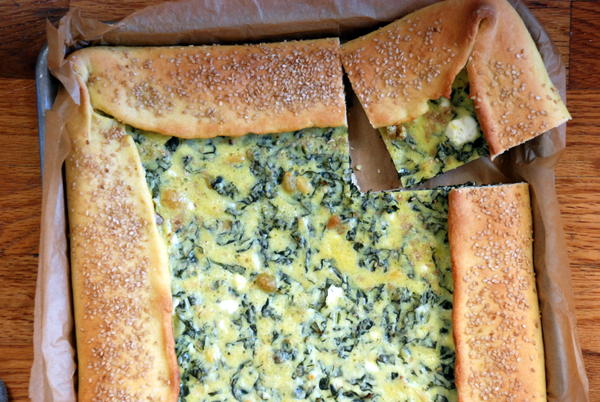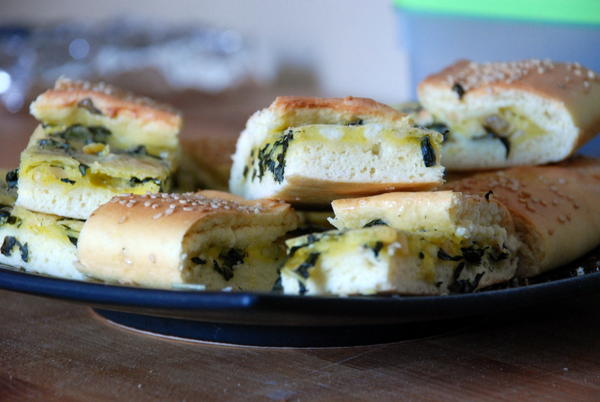Sometimes, when I really want to share a recipe with you, I go a little nuts with the testing and tweaking. The recipes I get most jazzed about are the ones I want to be most perfect. So I make the thing 5 or 6 times, fussing with quantities and baking times and potential extra ingredients, all so that when you make it yourself, it’s not almost perfect, it’s actually perfect.
This recipe had me at hello. I made it once, and immediately knew how I’d change it for posting. Chick-chock, were headed straight for primetime. Amazing!
I sat down in front of my computer and opened up a blank page. Now then: what to call it?
Uh.
Guys, I made this in March. Only now, practically mid-May, do I finally have a title that’s clear enough to tell you what you’re making. And I feel like if I just explain what’s actually in this thing-I-decided-to-call-a-pie, you’ll see why it was so hard to figure out what it actually should be called – and you won’t think I’m a total nutcase. But you will make it, yes you will, because it really is fantastic. So here goes.
The pie started with a recipe from The Traveler’s Lunchbox for flaounes, Greek Easter pastries. Right, I don’t celebrate Easter. But flaounes looked really really good, so they’ve been in my to-make folder ever since Melissa posted about them in 2010. In typical “I have too many recipes in my inbox” fashion, it took me until March to make them. The savory, triangular pastries seemed like the perfect companion to the hamentaschen I was already making for Purim. They were a big hit among friends.
But they were kind of fussy, with all the rolling and cutting and folding and pinching. And triangle pastries are a tough sell for a main course at a dinner party – they feel more like a snack. Between you and me, I don’t need cheese-filled dough lying around at snacktime. So on my next attempt, I went for a big slab pie. One piece of dough, rolled into a half sheet pan, filled with all the good stuff, and bam:Â lunch.
And a really good lunch at that. It reminded me a bit of those British “lunch dishes” that Nigella Lawson and others have written about: simple dough, stuffed with meat or cheese, baked till bubbly, then sliced and served just in time for the hunger pangs to strike. This was that. Incidentally, the leftovers kept quite well in the fridge. A 300-degree oven for 10 minutes did the trick in reheating, but once I even tried popping a slice in the toaster, which was quicker and more energy efficient.
Now then: what to call the flaounes-turned-pie? Flaounes probably means about as much to me as it does to you, which is to say, very little. I wanted you to know that this thing is loaded with greens and cheese. But let’s be honest: it’s not really a pie. Pie signals buttery, crumbly crust, which isn’t what you’ll get here. Instead, you’ll be making something more like a bread dough. It rises and puffs in the oven, and its exterior develops a sheen not unlike brioche or challah. Â I thought about casserole, but that didn’t seem right, either. Maybe “cheesy bread?
So forgive the slightly misleading name. Maybe let’s just call this lunch.
Cypriot Greens and Cheese Pie
adapted from The Traveler’s LunchboxI baked my
pie lunch dish in a half-sheet pan, which is 13″ x 18″. If you don’t have a half-sheet pan, you can easily divide your dough in half and make two pies in two quarter-sheet (9″ x 18″) pans.The mastic and machleb are quite distinctive, and they’re what give the dough its unique flavor. They’re available on Amazon (each linked appropriately0 but also on Kalustyans. As good as they are, though, you can skip them and still end up with a delicious dish.
For the dough:
5 cups (700g) all-purpose flour
1 1/2 teaspoons instant yeast
1 1/2 teaspoons salt
1 teaspoon mastic, ground in a mortar (optional; also called mastica)
1/2 teaspoon ground mahleb, (optional; also called mechlepi)
1 tablespoon sugar
3 large eggs
1/2 cup (125ml) milk
1/2 cup (125g) butter, melted and cooled
1/4-1/2 cup (60-125ml) lukewarm water, or as needed
vegetable oil, for greasing bowl and work surfaceFor the filling
:
1 lb 2 oz (500g) halloumi, kashkaval, pecorino, manchego, or a mixture of these cheeses, grated
1 1/2 tablespoons flour
7 large eggs; save a bit of one of the eggs for brushing on the dough
2 tablespoons dried mint
1/2 cup (50g) raisins or currants
8 oz. kale, chard, or other greens, shredded
1 teaspoon baking powder1/3 cup sesame seeds
In a large mixing bowl, mix the flour, yeast, salt, mastic, mahleb, and sugar. In a separate bowl, whisk together the eggs, milk and butter and add this to the flour. Add as much water as needed to get a soft but kneadable dough (I needed only 1/4 cup plus 1 tablespoon). If it’s too sticky to knead, add additional flour by the spoonful until you can knead it with clean hands without it sticking to your fingers. Turn the dough out onto a lightly oiled surface and knead until the dough is smooth and springy, about 5 minutes. Form the dough into a ball. Wash out the bowl, pour about a teaspoon of oil into the bottom, and put the dough in, rolling it around to coat it with the oil. Cover the bowl with a cloth and leave for about an hour, or until doubled in size. Fold the dough over itself a couple of times to deflate, cover the bowl with plastic wrap and refrigerate for at least 2 hours, or up to 24.
Meanwhile, mix all the filling ingredients except the baking powder (and a bit of one of the eggs, for brushing) and set aside. If refrigerating the dough overnight, cover and refrigerate the filling too.
Line your rimmed half-sheet pan or two rimmed quarter-sheet pans with parchment paper that extends beyond the edges of your pan(s). Set the dough on a lightly floured workspace and roll out into a roughly 16″ x 21″ rectangle (if using a half sheet pan) or two 12″ x “16” rectangles (if using 2 quarter-sheet pans). The exact shape of your dough doesn’t matter – you’re just going to fold the edges over the filling anyway, so don’t sweat it. Just make sure the dough comes up past the edges of your sheet pan(s).
Pour the filling into the pan(s), and fold the edges of the dough over the filling. The dough edges won’t even come close to covering the filling, and that’s okay. You should wind up with a sort of funky looking half-crust, half-topping. See my photos above.
Brush the folded-over part of the crust with the reserved egg, and sprinkle sesame seeds onto the crust.
Let the pie rise on the counter for about 30 minutes. Halfway into the rise, preheat the oven to 375 degrees and set a rack in the center of the oven.
Bake the pie for 35-40 minutes, until the center is firm and the top of the crust is golden brown. Set the pan on a rack to cool for 10 minutes, then serve.
Pie can be reheated a 300-degree oven for 10-15 minutes, or by popping slices in a toaster.




Comments on this entry are closed.
Looks like a great way to use the greens in my CSA box. Could I skip the raisins?
100%. Melissa even says they’re optional.
Looks great. Do you know what the baking powder in the filling does? Just curious.
Will have to try this, or some variation thereof. I think I’ll put in leeks too.
Chanie – I think it, with the bit of flour, helps the filling puff up. And funny about the leeks; I almost added them, too.